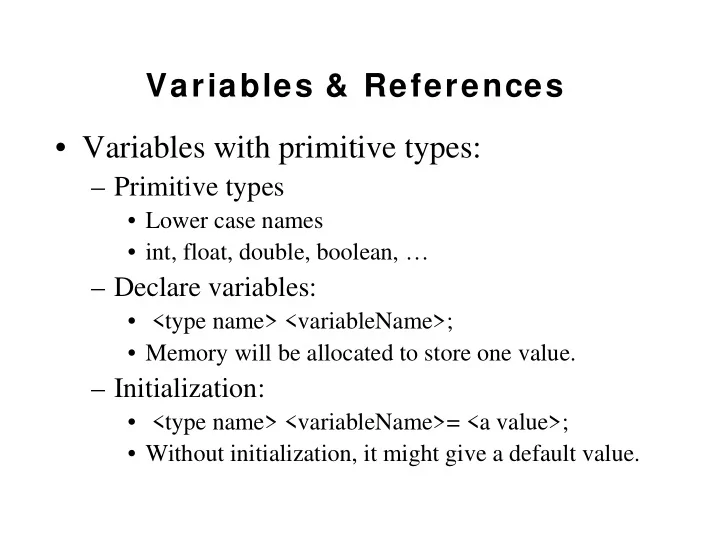

Variables & References • Variables with primitive types: – Primitive types • Lower case names • int, float, double, boolean, … – Declare variables: • <type name> <variableName>; • Memory will be allocated to store one value. – Initialization: • <type name> <variableName>= <a value>; • Without initialization, it might give a default value.
references • Variable of non-primitive type – Syntax of Delarations: • <ClassName> <variableName>; • ClassName should be in capital • Class must be created. – Declaration • It gives reference • It allocates memory for one reference; • It will give the initial value null • No object (of the class) is created
Exam ples • ClassName: class Rational { int numerator; int denominator; } • Declaration r Rational r; null
Object Creation • Syntax – Example Rational r ; Heap r = new Rational(); numerator 0 r denominator 0
Object Creation • properties – Use new to create – Access through reference – All objects created on heap • Assignment – No new object is created – Assign only the reference. – Example Rational r = new Rational(); Rational s; s = r; // s refers to same object
initialization • Use init – Example Rational r = new Rational(); r.init(0,1); – Remember: • Line one declares and use default to create an object. • Declare w/o object cannot be used to initialize with init.
initialization • Use the class constructors: example class Rational { // characteristics int numerator; int denominator; // a constructor Rational (int n) { numerator = n; denominator=1;} } // class end ……….. Rational r = new Rational(5);
Array as a reference • Array variables are references – Assign one array-variable to another array variable is copying reference – Example: int[] arrA = new int { 5, 7}; // picture in green int[] arrB; // picture in light blue arrB = arrA; // picture in arrow arrA 0 5 EEFE 1 7 arrB null
Arrays of References • Array of class type are arrays of references int[] arrR = new Rational[3]; // picture in green arrR[0]= new Rational(4); // picture in light blue arrR[1]= new Rational(7); // picture in light blue arrR[2]= new Rational(2); // picture in light blue arrR 4 1 0 1 7 1 2 2 1
Passing param eters • Passing a reference variable to a method (routine) is passing the reference, not the object.
Reference and m em ory • Reference is the address of the allocated memory. • Memory can only be accessed via reference. • Memory will NOT be accessible if we don’t have its reference. • Assign a new reference to a variable does not destroy the object of the old reference. • Memory of unusable objects are reclaimed by the Java VM. – Unusable when there are NO references to it – Java VM claims it by its own schedule – Reclaim it by activating garbage collection
Garbage Collection • Algorithm: – Go through the stack based references – Then via reference from stack trace through the heap and mark the used memory. – After the stack is check completely, go back to heap to collect the unmarked memory. Memory will NOT be accessible if we don’t have its reference. • We can invoke garbage collector protected void finalized() { flush(); flush();}
Recommend
More recommend